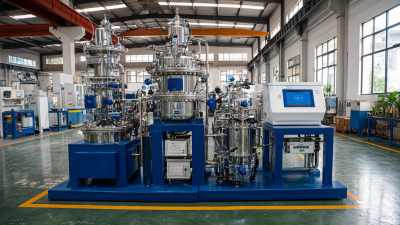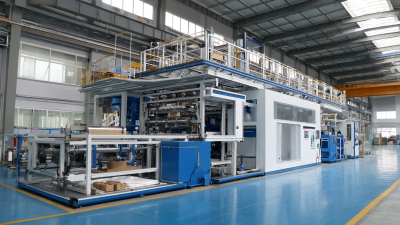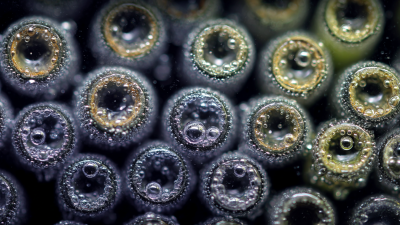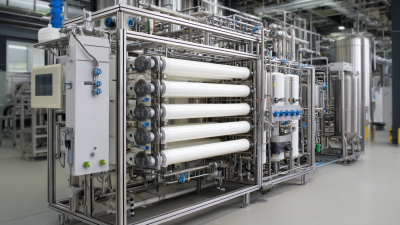Innovative Examples of Ultra Pure Water Purification Systems Transforming Industrial Standards
 In the quest for excellence across various industries, the demand for high-quality water has reached unprecedented levels. The global ultrapure water market is projected to grow significantly, with estimates indicating an increase to $8.6 billion by 2025, according to a recent report by MarketsandMarkets. This growth is driven by the necessity for ultra pure water purification systems in sectors such as semiconductor manufacturing, pharmaceuticals, and biotechnology, where even the slightest contaminants can alter processes and product quality. As industries evolve, so do the technologies aimed at achieving stringent purity standards. Innovative examples of ultra pure water purification systems are not only transforming manufacturing processes but are also setting new industrial benchmarks, ensuring that water quality meets the rigorous demands of modern applications. Understanding these systems is essential for stakeholders eager to leverage advancements that can lead to operational efficiency and enhanced product reliability.
In the quest for excellence across various industries, the demand for high-quality water has reached unprecedented levels. The global ultrapure water market is projected to grow significantly, with estimates indicating an increase to $8.6 billion by 2025, according to a recent report by MarketsandMarkets. This growth is driven by the necessity for ultra pure water purification systems in sectors such as semiconductor manufacturing, pharmaceuticals, and biotechnology, where even the slightest contaminants can alter processes and product quality. As industries evolve, so do the technologies aimed at achieving stringent purity standards. Innovative examples of ultra pure water purification systems are not only transforming manufacturing processes but are also setting new industrial benchmarks, ensuring that water quality meets the rigorous demands of modern applications. Understanding these systems is essential for stakeholders eager to leverage advancements that can lead to operational efficiency and enhanced product reliability.
Innovative Technologies in Ultra Pure Water Purification: A Comparative Analysis
In recent years, the demand for ultra-pure water (UPW) has surged across various industries, particularly in semiconductor manufacturing and pharmaceuticals. An industry report by Research and Markets states that the UPW market is projected to reach USD 9.67 billion by 2025, growing at a CAGR of 6.5%. Innovations such as membrane filtration technologies and advanced oxidation processes are reshaping how industries achieve required purity levels, allowing for reduced operational costs and improved efficiency. For example, the integration of reverse osmosis combined with electrodeionization is proving to be a benchmark for UPW systems, achieving contaminant removal rates exceeding 99.99%.
Tip: To enhance the efficiency of your UPW system, consider regular monitoring and maintenance. Implementing real-time analytical tools can help in identifying potential contamination sources promptly, ensuring that the water quality remains consistently high.
Another notable advancement is the implementation of hybrid systems that combine different purification methods. This comparative analysis has shown that systems employing multi-barrier strategies not only provide superior water quality but also optimize energy consumption. According to a study published in the Journal of Water Process Engineering, hybrid systems can save up to 30% energy compared to traditional methods, making them a sustainable choice in industrial applications.
Tip: Always stay informed about the latest purification technologies and trends. Attending industry conferences and seminars can provide valuable insights that can further enhance your operations and ensure compliance with stringent quality standards.
Exploring the Role of Membrane Filtration in Enhancing Purity Standards
In the realm of industrial water purification, membrane filtration has emerged as a pivotal technology, significantly enhancing the standards of water purity. This technique utilizes selective barriers that allow only specific molecules or ions to pass through while retaining contaminants. By employing various membrane types, including microfiltration, ultrafiltration, nanofiltration, and reverse osmosis, industries can achieve unprecedented levels of water purity essential for sensitive applications like pharmaceuticals, electronics, and food processing.

The adoption of membrane filtration systems reflects a growing awareness of the need for sustainable and efficient purification methods. These systems not only reduce the reliance on chemical additives but also minimize energy consumption compared to traditional purification processes. As industries face increasing regulations regarding water quality, the scalability and reliability of membrane technology are propelling it to the forefront of water treatment solutions. This innovation not only meets stringent purity standards but also paves the way for more sustainable industrial practices, ensuring that businesses can operate within environmental guidelines while maintaining high-quality outputs.
Impact of UV Disinfection on Water Safety in Industrial Applications
The integration of ultraviolet light-emitting diodes (UV-LEDs) in water disinfection is revolutionizing industrial standards for water safety. With their ability to effectively inactivate pathogens, UV-LED technology has gained significant traction in the disinfection equipment market, expected to grow from USD 3.87 billion in 2025 to USD 7.94 billion by 2030, representing a compound annual growth rate (CAGR) of 15.4%. This advance not only enhances microbial safety but also provides a more efficient and eco-friendly alternative to traditional chemical disinfection methods.

Moreover, the rising demand for reliable water purification solutions in various industrial applications is driving this trend further. Recent reviews on UV-LED applications confirm their remarkable efficacy, particularly in treating agricultural water, where they demonstrated superior cost-effectiveness compared to other disinfection technologies. As the water crisis intensifies globally, the focus on UV disinfection systems will likely become more pronounced, affirming their role in safeguarding water quality across sectors.
The expanding UV disinfection equipment market underscores the growing acknowledgment of UV technology as a pivotal player in ensuring safe and ultra-pure water for industrial use.
Case Studies: Successful Implementation of Ultra Pure Water Systems in Key Industries
The implementation of ultra-pure water systems has become a transformative trend across industries, driven by the necessity for stringent quality standards. For instance, in the semiconductor manufacturing sector, companies are adopting advanced purification technologies to meet the high purity requirements, which often necessitate water of 18.2 megohm-cm resistivity or higher. Additionally, according to a report by the Water Quality Association, the global market for ultra-pure water systems is projected to grow significantly, with an anticipated compound annual growth rate (CAGR) of 8% over the next five years as industries aim to enhance their operational efficiency.
In the pharmaceutical industry, ultra-pure water systems not only ensure compliance with regulations but also play a crucial role in product quality. A case study highlights a major pharmaceutical company that integrated a new filtration system, resulting in a 25% reduction in water usage and a 30% improvement in product batch consistency. These advancements reflect a broader trend where organizations are leveraging innovative purification technologies to drive both sustainability and operational excellence, paving the way for a more efficient industrial landscape.
Future Trends: How IoT and AI Are Shaping Water Purification Processes
The intersection of IoT and AI is revolutionizing water purification processes, paving the way for unprecedented efficiency and effectiveness. IoT devices play a crucial role in monitoring water quality in real-time, providing valuable data that helps identify contamination sources and optimize treatment methods. With sensors integrated throughout purification systems, operators can receive instant alerts about water quality fluctuations, enabling proactive measures that maintain high standards of ultra-pure water.
Meanwhile, AI enhances these systems by analyzing the vast amounts of data generated by IoT sensors. Machine learning algorithms can predict maintenance needs, minimizing downtime and reducing operational costs. Furthermore, AI-driven analytics enable a deeper understanding of purification trends, helping industries to adapt their processes to emerging contaminants and regulatory standards. Together, IoT and AI not only streamline purification processes but also ensure that industries are equipped to face the evolving challenges of water quality management in a sustainable manner.
Water Purification Technology Efficiency Trends
This chart illustrates the efficiency of various water purification technologies, showcasing how traditional systems compare to modern advancements like IoT and AI integrations. As industries adopt more sophisticated methods, a significant increase in efficiency can be observed.
Related Posts
-

Unwavering Quality from Trusted Chinese Manufacturers Featuring the Best Vacuum Filtration Systems
-

Ultimate Guide to Mastering Cross Flow Filtration Systems for Enhanced Efficiency
-

How to Choose the Right Wood Pulp for Your Paper Production Needs
-

Unveiling the Advantages of the Best Pulp Molding Machines for Diverse Product Applications
-

Exploring Alternatives to Best Microfiltration Membrane Technology for Enhanced Water Purification
-

5 Industry Applications of the Best Cross Flow Filtration: 7 Compelling Reasons for Implementation